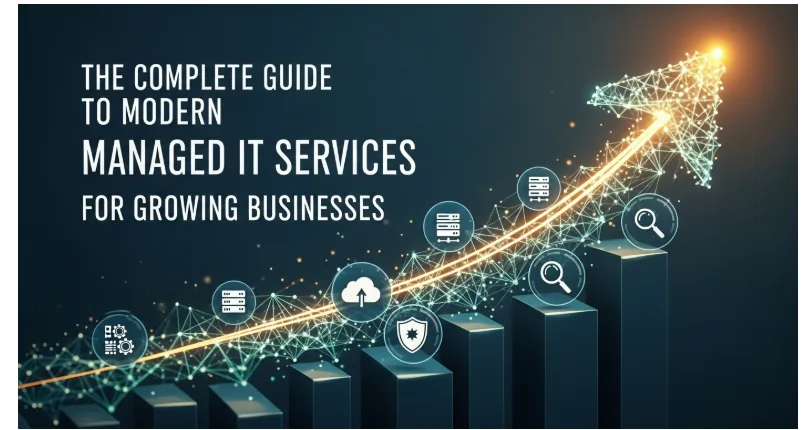The Complete Guide to Modern Managed IT Services for Growing Businesses

Running a modern business means juggling cybersecurity, cloud systems, remote users, data backups, device management, and nonstop digital demands. It’s no surprise that companies are turning to Managed IT Services as a dependable way to stay ahead without overloading internal teams. Whether you’re trying to scale efficiently or simply keep operations stable, strategic technology support has become a necessity—not a luxury.
As technology continues evolving at lightning speed, many organizations also turn to Outsourced IT Support to fill skill gaps and keep their systems running at peak performance. At the same time, the broader world of IT Services has expanded to cover everything from security monitoring to cloud orchestration, making it easier than ever to build a lean, secure, highly productive digital environment.
Why Businesses Are Shifting Toward Managed IT Services
Rising Complexity of Digital Infrastructure
Every year, systems become more interconnected. Businesses now rely on layered networking, cloud platforms, mobile devices, and data-heavy applications. That’s where Managed IT Services shine—they provide expertise necessary to manage complexity without adding internal headcount.
The Demand for Cost-Effective Scalability
Scaling traditional IT teams is expensive. Hiring specialists for cybersecurity, networking, and cloud engineering quickly adds up. A structured IT Services framework can expand or contract based on business needs, offering predictable monthly costs.
Minimizing Downtime in a Competitive Market
System downtime kills productivity. Managed service teams provide real-time monitoring and rapid response, keeping operations stable.
What Managed IT Services Typically Include
Network Monitoring and Optimization
Proactive monitoring ensures connectivity stays strong. A managed team handles:
- Bandwidth balancing
- Hardware alerts
- Outage prevention
This approach makes Managed IT Services one of the best ways to maintain uptime.
Cybersecurity and Threat Prevention
Today’s threat landscape demands more than antivirus software. Managed teams implement:
- Firewalls
- Endpoint detection
- Email filtering
- Security audits
Cloud Management and Remote Infrastructure
From cloud migrations to platform management, IT Services deliver continuous optimization and resource management.
Help Desk and End-User Support
End-users need fast support. Managed help desks reduce frustration and improve productivity.
Understanding the Power of Outsourced IT Support
When Outsourcing IT Becomes a Strategic Advantage
Some companies handle day-to-day operations internally while partnering externally for advanced tasks. This blend of internal and external experts creates efficiency.
Key Functions Commonly Outsourced
Businesses often rely on Outsourced IT Support for:
- Security monitoring
- Backup management
- Cloud architecture
- System automation
How Outsourced IT Support Improves Operations
It reduces bottlenecks, cuts hiring costs, and ensures access to specialized expertise that might otherwise be unavailable.
The Role of IT Services in Modern Business Environments
Business Continuity and Disaster Recovery
A strong disaster recovery plan protects you from data loss and unexpected outages.
Technology Planning and Roadmapping
Strategic IT planning helps avoid outdated systems and ensures future readiness.
Compliance, Auditing, and Risk Management
Governance requirements are tightening. Reliable IT Services help document, secure, and manage compliance workflows.
Managed IT Services vs. Traditional In-House IT
Financial Comparison and Budget Impact
Outsourcing is often more cost-effective than building a full internal IT team.
Service Quality and Response Times
External teams usually offer quicker response times due to dedicated support structures.
Talent, Skills, and Technology Gaps
Finding advanced-level experts is tough. Managed teams fill critical gaps seamlessly.
How Managed IT Services Strengthen Cybersecurity
Proactive Monitoring
Threats are detected and neutralized before they disrupt operations.
Zero-Trust Architecture and Access Controls
Modern workplaces rely heavily on zero-trust frameworks to secure remote and hybrid environments.
Vulnerability and Patch Management
Consistent patching prevents system weaknesses from becoming major security breaches.
Why More Companies Rely on Outsourced IT Support
Reducing Operational Stress on Internal Teams
Internal teams can focus on strategic initiatives instead of constant troubleshooting.
Accessing Senior-Level Expertise Without Hiring Costs
Instead of hiring full-time specialists, businesses use Outsourced IT Support to get high-level skills on demand.
Eliminating Bottlenecks and Workflow Delays
Lean teams benefit immensely from external assistance.
Choosing the Right Provider of IT Services
Evaluating Service-Level Agreements (SLAs)
Transparent performance commitments are essential.
Understanding Transparent Pricing Models
Predictable pricing helps businesses manage budgets effectively.
The Importance of 24/7 Availability
Around-the-clock support keeps global operations running smoothly.
Future Trends in Managed IT Services and Outsourcing
AI Automation and Predictive Maintenance
AI-driven systems anticipate issues before they escalate.
Hybrid Cloud and Edge Computing
Businesses are adopting hybrid environments to balance control and flexibility.
The Shift Toward Fully Managed Cyber Defense
Comprehensive IT Services increasingly include advanced managed detection and response (MDR).
Final Thoughts
The shift toward Managed IT Services, Outsourced IT Support, and full-spectrum IT Services is reshaping how modern companies operate. Businesses now expect their technology to be stable, secure, scalable, and future-ready. Outsourcing—or partially outsourcing—technology management is no longer just a cost-saving tactic; it’s a strategic move that supports long-term growth, productivity, and digital resilience.
As IT environments grow more complex, leaning on expert support becomes one of the smartest moves any organization can make.
FAQs
1. What are the main benefits of Managed IT Services?
They provide proactive monitoring, improved security, predictable costs, and faster issue resolution.
2. How does Outsourced IT Support differ from in-house support?
Outsourcing gives you a team of specialists without the overhead of full-time hiring.
3. What do IT Services include?
They typically cover cloud management, cybersecurity, network operations, help desk support, and technology planning.
4. Can businesses use both internal IT staff and Managed IT Services?
Absolutely—many organizations use a hybrid model for maximum efficiency.
5. Are Managed IT Services suitable for small companies?
Yes. Smaller organizations often benefit the most since outsourcing replaces the need for multiple specialized hires.
